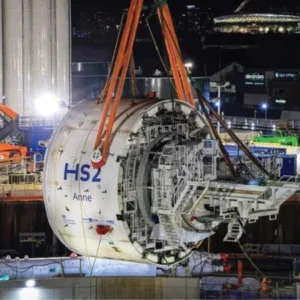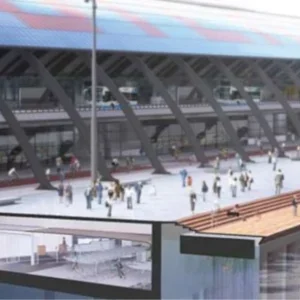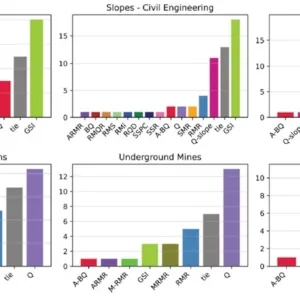The Zurich-Thalwil double-track railway tunnel, the first part of the 22km Zimmerberg Tunnel, will relieve the existing overburdened Lake line and will provide access to eastern Switzerland and the Gotthard Base Tunnel, which is to be built in the near future. This first section runs from downtown Zurich, along the border of Lake Zurich and ends in the small village of Thalwil. With a length of 9400m it will be one of the major railway tunnels in Switzerland, and also the most expensive single project ever attempted by Swiss Railways, with a price tag of $266.7m.
The contact was awarded to a JV of Zschokke/Locher; Prader; Murer; CSC; Specogna; and Scheifele, all from Switzerland; and Wayss & Freytag of Germany.
The project is divided in two parts: Lot 3.01 comprises the section north of the installation site, which is 5.7km long with some intermediate shafts. The alignment is completely in weak rock and will be excavated with a Herrenknecht 12.3m diameter shielded TBM.
The second section, Lot 2.01, leads downtown and ends at Zurich’s mainline station. In this part of the project, the ground is substantially more difficult. In addition, the route is a real challenge, being right under the foundations of Zurich’s densely built-up city centre. One high-rise building had to be underpinned and the lowest cellar floor dismantled to allow for the machine to pass under it.
Geology
The geological profile shows weak rock at the beginning of the route. However, after only 150m, the overlying soft soil of Lot 2.01 plunges into the face. This depression is about 200m long. Then the alignment passes into weak rock again until the Kollerwiese intermediate shaft, about 700m before the end of the drive. Those 700m consist initially of soft soil containing lake deposits, and then a mixture of coarse gravel; sand and large blocks; and boulders.
|
“The route of Lot 2.01 is a real challenge, being right under the foundations of Zurich’s densely built-up city centre” |
To deal with these variable ground conditions, a Herrenknecht Mixshield with an o.d. of 12.4m, which can be converted from rock to slurry mode and vice versa, was chosen. The cutting head can be moved 600mm longitudinally. The maximum torque installed is 1460mt and the rotational speed is 0-4 rev/min, infinitely variable. The cutterhead is equipped with 170 roller discs. It is completely closed at the start of the drive and, as such, is equal to a hard rock cutterhead.
It is intended initially to drive the machine in rock mode and to convert it before the first soft ground depression into slurry shield mode, but without opening the wheel and without installing ripper teeth. After the soft soil, the machine will work again in rock mode. At the Kollerwiese intermediate shaft, 700m before the end of the drive, the machine will finally be converted to the slurry mode.
Machine conversion
The face of the cutting wheel will be opened and ripper teeth installed. The roller discs, however, will be retained to destroy the blocks and to cut through injected zones. The crusher, handling stones with a diameter up to 500mm, will also be functioning. Two airlocks will be connected to the existing flanges. Feeding and discharging pipes in the area of the shield, the trailing back-up and in the tunnel have a diameter of 400mm. Pumps and a separation plant with centrifuge are designed for a capacity of 1400m³/h in the circuit.
A pilot tunnel of 3.7m diameter will be excavated parallel to the alignment from the Kollerwiese intermediate shaft, originally intended as a place to convert the machine at atmospheric pressure. Due to the extremely small distance between the foundations of the houses and the top of the tunnel, certain critical areas will be treated by means of injection with cement grout from the pilot tunnel. As already noted, roller discs are installed to cut through these zones.
The segments will be manufactured on the site, which is in turn connected to the railway. The two-pass lining for the tunnels differs slightly because Lot 2.01 leads partly through waterbearing soft soil. The segmental ring for the rock tunnel consists of five elements, 300mm thick and 1.7m wide, and a key, whereas the ring for Lot 2.01 has seven segments and a key, having the same thickness and width. In the waterbearing portion, this ring is sealed against groundwater.
|
“More than 3m tonnes of muck are to be removed by conveyor belts in the tunnel, a vertical elevator and then a conveyor belt to the trains” |
The large amount of cement and aggregate, as well as muck, will be transported by rail. To serve the batching plant and for loading the railroad cars with muck, an elaborate system of conveyor belts has been designed. The numbers involved are staggering. More than 3m tonnes of muck are to be removed by conveyor belts in the tunnel, a vertical elevator and then another conveyor belt to the trains. Cement and aggregate for about 370 000m³ of concrete for the segments must be delivered to the site.
Progress of the machines
The hard rock machine started work on September 15 1998. The average rate of progress was 25 m/day, with a maximum of 39.1m, working in two shifts. Up to now, about 3000m of tunnel have been excavated. The dual-mode machine was put to work on March 31 1999. Having driven about 180m, it is still in the start-up phase.
The pilot tunnel encountered more difficulties. This 3.7m pipejacked heading, excavated by a slurry shield, hit an area consisting soley of blocks and boulders which reduced the speed to almost zero. The shield’s skin was abandoned and the machine dismantled. Tunnelling continued using shotcrete and achieved reasonable results. The total length of 470m was finished at the end of July 1999, just in time to start injecting the ground to protect the buildings.
Excavation of the Zurich-Thalwil Tunnel will be completed at the end of June 2001. Commissioning is planned for June 1 2003.
Related Files
Location and Layout
Tunnelling Section






